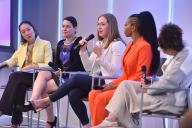Brandee Evans plays pole dancer Mercedes in the Starz drama P-Valley. Off screen, she is also a caregiver to her mother, who has multiple sclerosis and early-onset Alzheimer's disease.
"When people see an actor, they think, 'Oh, she's so rich,'" Evans said. "But it costs me $9,000 a month to film that show. Because it costs $300 a day to leave my mother [with an at-home caregiver]. And if we're filming for eight months, there goes my check.”
Dispelling television myths about caregivers and caregiving while encouraging authentic representation was the goal of the Television Academy Foundation's public program, "The Power of TV: Flipping the Script on Work, Family & Care." Held May 8 at the Academy’s Saban Media Center in the NoHo Arts District, the event was the first in the “Power of TV”’s seven-year history that presented not only a panel of subject experts and industry members but follow-up breakout sessions for deeper conversation among the attendees.
Evans, a panelist and member of the Creative Care Council of the national organization Caring Across Generations, welcomed the opportunity to amplify the realities of caregiving. Participants also included Lydia Storie, director of culture change at Caring Across Generations; Vicki Shabo, senior fellow for gender equity, paid leave and care policy, as well as strategy and entertainment initiative at New America’s Better Life Lab; and Angela Nissel, executive producer of the Netflix series Ginny & Georgia. Rebecca Sun, senior editor of diversity and inclusion at The Hollywood Reporter, was the moderator.
Television often doesn't depict the high cost of caregiving. In the United States, 73% of people who work also provide some type of family care, be it for children, parents or other loved ones with disabilities. But studies have found that on television, childcare factors into only about 20% of all storylines, while aging and disability caregiving show up in about a quarter of stories about providing care. According to the panel, men often are depicted as breadwinners but rarely as caregivers, and care stories focus on white families, ignoring such diverse identities as people of color, immigrant communities and/or the LGBTQ community. And young people, who in real life care for parents and grandparents, are often not portrayed doing so on screen.
One myth in particular the panelists would like to see vanish is that of what they called the "hero’s journey" of the self-reliant, self-sacrificing caregiver going it alone rather than asking for help.
"We did a video with [actress] Yvette Nicole Brown, who sits on the Creative Care Council, called ‘Caregivers Don't Wear Capes,’ to dismantle this idea that it's, 'Oh, we celebrate you for doing it all. And you're so great at sacrificing yourself,'" Storie said. "Why don't we normalize stories that show people working together to be heroes, a collective journey and success? And, also, dismantle the stigma in this country around needing or providing help. We need to rewrite that story, too, and show people, whether it's in a care situation or not, that it's okay to ask for help and depend on other people."
Evans coped with the transition by turning to friends, both women and men, for help and support, and, she said, “scavenged” the internet for resources. Nissel, who is a caregiver for her mother, injects comedy into caregiving storylines.
"Being in multiple writers' rooms, it is what the showrunner knows themselves, and it's about me coming in the room and kind of forcing [the writers] to see, 'This is really funny,'" she said. "Even [telling a story on the panel] about my mother. I have to realize that I have to lead with the funny. Because when people hear caretaking, they think, 'Oh, it’s hard' — but what is comedy, except someone with a goal trying to get through several hellish moments to reach that goal? And that's what caretaking always is. So, to me, it's inherently funny. It's about proving to other people that it's funny."
Including onscreen caregiving can be done subtly, something as simple as showing two employees talking in front of a childcare facility. So, when it comes to storylines, why is there such a gap between real life and what’s on screen?
"I think so much of this is about who's writing stories," Shabo said. "It's also about what Hollywood thinks is entertaining … misperceptions about what people want to see.” New America's recent research with the MarketCast company "found that 84% of streaming audiences want to see realistic depictions of work, family and care on screen. And 60% say that they would be very enthusiastic about seeing more gender equity: Women who are succeeding both at work and being loving parents at home, men who are providing care onscreen to children in a competent way, not in a trophy way. They want to see people looking for and finding resources like paid leave and childcare. And we know that audiences, when they're engaging online, are engaged more with stories that include work, family and care."
Speaking to the power of storytelling, Sun wrote an article published that very day by The Hollywood Reporter detailing the results of a study by Caring Across Generations and the USC Norman Lear Center’s Media Impact Project. It explored how the storyline on NBC's 2016-2022 drama This Is Us about Pearson family matriarch Rebecca's (Mandy Moore) Alzheimer's disease had affected viewers' attitudes toward care in their own lives.
"What we found was that audiences were inspired to actually go online, talk more about care the way they've experienced it in their lives, reflect on it, understand it in new ways, start realizing that, 'Wow, this is something I'm not in alone,'" Storie noted. "There are so many other people who've experienced this."
An episode showcasing Rebecca's second husband, Miguel (Jon Huertas), her primary caregiver, particularly resonated. "[The episode] around a 'Latinate' immigrant family and the way that care played out, and the cultural nuances and the value system within that particular family, drove five times more engagement on social media, because people realized they had hardly ever seen themselves reflected in that way before," she added.
"So not only do people want to see these things — they also want to see them in inclusive, authentic, culturally specific and resonant ways."
Caring Across Generations has created a media guide, called the Care Inclusion Playbook, "to help people see some of these more inclusive and culturally nuanced ways of telling stories, that we are convincing the industry that audiences actually want to show up for and engage with,” Storie said.
Following the opportunity to network after the panel, interested audience members joined one of two breakout sessions, facilitated by Storie and Shabo. Shabo's group talked about depicting both care recipients and caregivers with agency and self-determination; the difference between true representation and tokenism; and the influence of diversity in the writers' room and in production.
Storie's attendees became somewhat of a support group, with participants sharing not only story ideas, but their own experiences with caregiving for family members of various ages and conditions and the challenges of work-life balance, lack of support and coping with stress. Of such experiences becoming fodder for projects, one writer-producer suggested: "I'd make it so that people get that rollercoaster ride, but then also come out feeling inspired."
The event was sponsored by Caring Across Generations and New America’s Better Life Lab.














